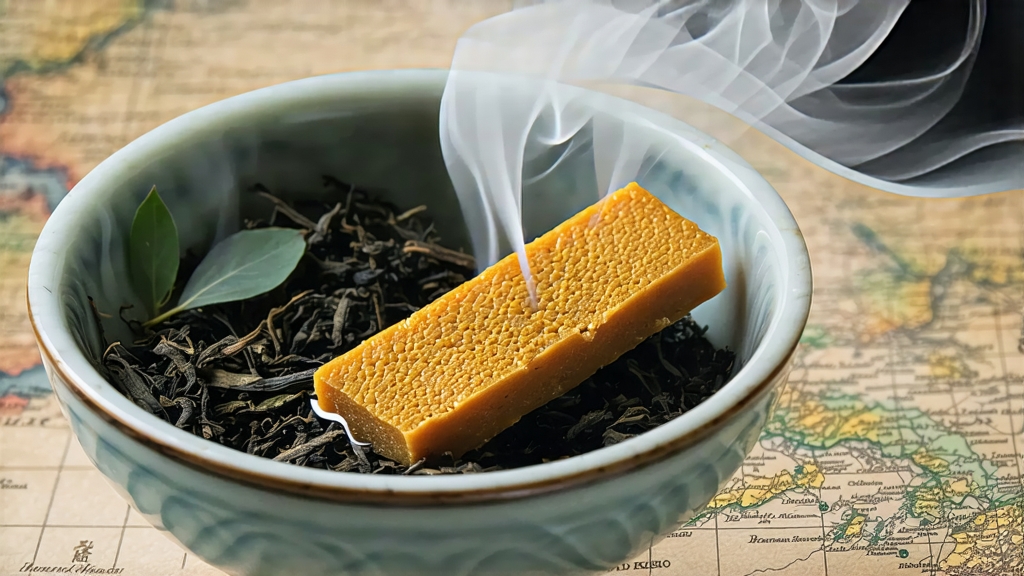
If black tea is the flamboyant diplomat of the Chinese tea family, dark tea (heicha) is its quiet philosopher, content to mature in the shadows until the moment of revelation. Among the six major dark teas—Yunnan Pu-erh, Hunan Qianliang, Hubei Qingzhuan, Sichuan Biancha, Guangxi Liubao—the least sung yet most enigmatic is Fu brick tea, a compacted marvel whose very surface blooms with microscopic golden constellations. To international drinkers who equate “fermentation” with grape or hop, Fu brick offers a parallel universe where mold is ally, time is ingredient, and every cup tastes like the echo of caravans that once crossed the deserts of Central Asia.
Historical footprint
Fu brick was born of taxes and camels. During the Ming dynasty (1368-1644) the imperial court replaced the volatile Sichuan tea monopoly with a “tea-for-horses” barter system along the northwest frontier. Caravans needed a tea that could survive six-month journeys from Hunan to Kashgar without spoiling. In 1860 a small workshop in Jingyang county, Shaanxi, discovered that if lightly steamed Hunan maocha was re-pressed into 2-kilogram bricks and stored above the camel stables, a radiant yellow dust—later identified as Eurotium cristatum—appeared. Traders dubbed it “golden flowers” (jin hua) and considered the glitter a guarantee of safe passage. By the Qing, Fu brick had become currency itself: one brick could buy two Mongolian warhorses or pay the monthly salary of a border guard. When the Tea Horse Road faded in the 1950s, the bricks never stopped traveling; they simply changed direction, finding new pilgrims in Tokyo tearooms, Paris wine cellars, and now Brooklyn cafés.
Terroir and leaf pedigree
Authentic Fu brick begins in the mist-locked foothills of Hunan’s Anhua county, where the Zijiang River cuts a granite gorge whose diurnal temperature swing stresses the tea bushes into producing unusually thick, pectin-rich leaves. Only the third and fourth leaves—considered too coarse for green tea—are plucked after the Grain Rain festival. Their lignified veins provide the porous scaffolding on which Eurotium will later weave its golden velvet. After plucking the leaves are withered under reed mats, pan-fired at 280 °C for eight minutes to kill green enzymes, then rolled for 40 minutes until the cell rupture rate reaches 65 %. What follows is not the familiar “black tea” oxidation but a slow microbial fermentation that can last anywhere from 20 days to 20 years.
Crafting the golden flowers
The magic happens in the “flower room” (fa hua fang), a humid brick chamber kept at 28 °C and 78 % relative humidity. Steam is injected until the air smells like warm chestnuts; then the semi-fermented maocha is re-blended with 5 % previous-year Fu brick dust—an inoculation akin to sourdough starter. The mixture is weighed into 2 kg linen-lined molds and compressed under 25-ton hydraulic presses just long enough to weld leaves together without crushing their veins. Bricks are then stacked in Jingyang-style pagoda piles, each layer separated by bamboo slats that allow a whisper of air. Over the next 12–15 days Eurotium blooms, its filamentous hyphae secreting extracellular enzymes that convert cellulose into soluble sugars, polyphenols into theaflavins, and bitter amino acids into mellow γ-aminobutyric acid. When the golden spots reach a density of 30,000–50,000 per gram—visible under a 10× loupe as tiny starfish—the bricks are slowly dried at 45 °C over 7 days to lock the aroma.
Decoding the flavor matrix
Cupping a 2016 Jingyang “Silk Road” Fu brick is like tasting a library. First infusion (95 °C, 10 s): damp earth and dried apricot, reminiscent of a first-edition atlas. Second infusion (95 °C, 15 s): camphor and fermented honey, the page where merchants recorded snowstorms. Third infusion (95 °C, 25 s): a sudden lift of rose-hip acidity, the ink that once sketched oasis palms. The liquor is ox-blood